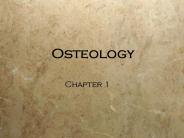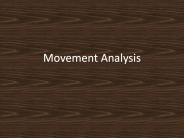Condyloid PowerPoint PPT Presentations
All Time
Recommended
Joints: provide bones with a ... shape to condyloid, both bone ends are convex, biaxial. ... Synarthrodal: two bones joined by cartilage or fibrous tissue, ...
| PowerPoint PPT presentation | free to view
Classified how adjacent bones are joined. fibrous, cartilaginous, bony or ... more movable than a condyloid or hinge joint forming the primate opposable thumb ...
| PowerPoint PPT presentation | free to view
not the same as 'Paget's Disease of the Breast and ... inversion/eversion. opposition. Synovial Structures. Plane (gliding, sliding) Condyloid (ellipsoid) ...
| PowerPoint PPT presentation | free to view
Types of Synovial Joint Notes Plane Joint articular cartilages are essentially flat; short slipping and gliding movement Example: intercarpal joints of wrist ...
| PowerPoint PPT presentation | free to download
Gomphosis- teeth. Syndesmosis- between ulna and radius. Cartilaginous joints ... Gliding- articular processes of vertebrae. Pivot- atlas (C1) and dens of axis (C2) ...
| PowerPoint PPT presentation | free to view
Joints Joints A joints structure determines how it functions. The closer the bones fit the stronger the joint. Tightly fitting joints restrict movement.
| PowerPoint PPT presentation | free to view
JOINTS OF THE SKELETAL SYSTEM ... Knee CLASSIFICATION OF JOINTS Based on Construction Materials Fibrous CT ... together Types Syndesmosis Suture ...
| PowerPoint PPT presentation | free to view
Joints Articulations Functions Hold the bones together securely Give the rigid skeleton mobility Joint Classification According to Function Synarthroses ...
| PowerPoint PPT presentation | free to view
THE SKELETAL SYSTEM Chapter 14 Lesson 1 part 2 * * * * * * * * * * * * * * * * * * * * * * * joint a connection between two or more bones or between cartilage and ...
| PowerPoint PPT presentation | free to download
1. ARTHROLOGY. THE STUDY OF JOINTS. A. INTRODUCTION - joints have a joint capsule, ... There are three major types of joints: 1) Fibrous (immovable) ...
| PowerPoint PPT presentation | free to view
C. syndesmosis B. diarthrosis The interosseous membrane between the radius and ulna borders forms what type of joint?
| PowerPoint PPT presentation | free to download
The turning of a bone around its own long axis. Examples. Between first ... Articular surfaces are essentially flat. Allow only slipping or gliding movements ...
| PowerPoint PPT presentation | free to view
... lubricate joint distribute nutrients and remove waste products shock absorber defense Accessories of Synovial Joint Cartilage fibrocartilage ...
| PowerPoint PPT presentation | free to download
Types of Movements at Synovial Joints Groups of Movements Gliding Angular Rotation Special Movements Gliding A simple movement in which relatively flat bone surfaces ...
| PowerPoint PPT presentation | free to download
Levers and Joints Lever Components Lever Fulcrum Effort Resistance MAE: Moment Arm of Effort MAR: Moment Arm of Resistance Three types of levers Levers (Type I) F E R ...
| PowerPoint PPT presentation | free to view
The bones of the tarsus do not belong to individual toes, whereas those of the metatarsus do. ... ulnas of the arms, and the phalanges of the fingers and toes. ...
| PowerPoint PPT presentation | free to view
GENERAL ARTHROLOGY Synarthrotic Joints No joint capsule and no movement between adjacent bones Suture Dense Fibrous CT Gomphosis Fibrous Peridontal Ligaments ...
| PowerPoint PPT presentation | free to view
GENERAL ARTHROLOGY Synarthrotic Joints No joint capsule and no movement between adjacent bones Suture Dense Fibrous CT Gomphosis Fibrous Peridontal Ligaments ...
| PowerPoint PPT presentation | free to view
'Never Lie To a Preacher, The Truth Comes Home' 'New Lovers Try ... Thumb is 1, 'pinky' is 5. Phalanges. Proximal, intermediate, & distal. Radius & ulna ...
| PowerPoint PPT presentation | free to view
... is stiffer & can withstand greater stress, but less strain than cancellous. Cancellous is spongier & can undergo greater strain before fracturing. Bone Properties ...
| PowerPoint PPT presentation | free to download
Cartilaginous Joints Bones connected by hyaline cartilage (fibrocartilage) Limited movement Examples: intervertebral discs, symphysis pubis, ...
| PowerPoint PPT presentation | free to download
Most movable of the joint types. Fibrous Joints. Suture. Syndesmosis. Gomphosis. Cartilaginous joints. Synchondrosis. Symphysis. Types of Synovial Joints ...
| PowerPoint PPT presentation | free to view
GENERAL ARTHROLOGY Synarthrotic Joints No joint capsule and no movement between adjacent bones Suture Dense Fibrous CT Gomphosis Fibrous Peridontal Ligaments ...
| PowerPoint PPT presentation | free to view
Skeletal System Chp. 7
| PowerPoint PPT presentation | free to view
What movement is produced when a joint is straightened? A. Extension. B. Flexion. D. Adduction ... Flexion. D. Abduction. C. Rotation. Try again! Try Again. Question 7 ...
| PowerPoint PPT presentation | free to view
Articulations- points where two or more bones come together to form a joint ... Bones are held tightly connected by fibrous connective tissue or cartilage. ...
| PowerPoint PPT presentation | free to download
found in vertebrae, hip bone and sternum all life. 2. ... Gomphosis. Fibrous joints. Syndesmosis. Cartilagenous joints. Synchondrosis. Cartilagenous joints ...
| PowerPoint PPT presentation | free to download
Movement Analysis Basic analysis of movement can be done visually and should involve the following A description of the actual movements which occur at the joints ...
| PowerPoint PPT presentation | free to download
Title: Bio211 Lecture 15 Subject: Articulations Author: Greg Erianne Last modified by: Gregs Desktop Created Date: 1/14/2003 8:00:03 PM Document presentation format
| PowerPoint PPT presentation | free to download
Chapter 9 Articulations
| PowerPoint PPT presentation | free to download
Bones connected with fibrous tissue: ligament. Skull sutures and distal Tibia/Fibula ... Non-axial: bone surface is flat. Plane or gliding joint ...
| PowerPoint PPT presentation | free to view
Articular surfaces are essentially flat. Allow only slipping or gliding movements ... of the long head of biceps, which travels through the intertubercular groove ...
| PowerPoint PPT presentation | free to view
The muscular system Aims of the session To recap on the skeletal system. To understand the structure and function of synovial joints. To understand the anatomy of a ...
| PowerPoint PPT presentation | free to view
Can withstand relatively rigorous joint environment without failure. Isolated tissue ... Abnormal Joint Articulation. Cartilage degeneration ...
| PowerPoint PPT presentation | free to download
SKELETAL SYSTEM NOTES 4 Major Functions Framework Protection Storage Blood cells Generic Parts Periosteum Endosteum Epiphysis Diaphysis Epiphyseal Cartilage Yellow ...
| PowerPoint PPT presentation | free to download
Joints. Chapter 9. Classified structurally and functionally ... hyaline cartilage. synarthrosis. 2. Symphysis. fibrocartilage. found on midline of body ...
| PowerPoint PPT presentation | free to download
THE SKELETON ... joints
| PowerPoint PPT presentation | free to view
Title: Slide 1 Author: Dr. Anatomy Last modified by: Mastour Created Date: 9/10/2006 7:18:38 AM Document presentation format: On-screen Show Company
| PowerPoint PPT presentation | free to view
You will be able to identify where in the body these synovial joints are. You will understand how these joints help ... Example: Carpal Bones (hand). Your Task ...
| PowerPoint PPT presentation | free to view
Skeletal System By: Oscar Aguilera & Vince Maala Ball and Socket allows rotation. There is a ball shaped end to a bone which sits in a socket and is able to move in ...
| PowerPoint PPT presentation | free to view
Sutures better described as synostoses (skull) ... Radial Annular Ligament. Articular Capsular Ligaments. Common Joint & Movement Problems ...
| PowerPoint PPT presentation | free to view
Bone Composition and Its Relationship to Bone Stiffness ... Measuring. Goniometer. Videotape/Motion Analysis. Electrogoniometer ...
| PowerPoint PPT presentation | free to view
Joints - Lancaster High School ... Joints
| PowerPoint PPT presentation | free to download
Lower Limb Femur Patella Tibia Fibula Tarsals Metatarsals Phalanges Femur Longest and strongest bone in the body Head at top fits into _____of coxa Greater trochanter ...
| PowerPoint PPT presentation | free to download
THE SKELETON Objectives Identify the bones that articulate at different joints in the body. Name the 6 types of synovial joint and give examples of each.
| PowerPoint PPT presentation | free to download
Pivot Point The point that the joints rotate about. ... Pivot Joint. An example of a pivot joint is the ability of the bone on the forearm to rotate ...
| PowerPoint PPT presentation | free to view
Title: LU-1 In the space medial to the greater tubercle of the humerus in the superficial pectoral muscle at the level of the 1st intercostal space.
| PowerPoint PPT presentation | free to download
Instructions for using this template. Remember this is Jeopardy, so where I have written Answer this is the prompt the students will see, and where I have ...
| PowerPoint PPT presentation | free to download
Arthrology = study of joints. Kinesiology = study of motion. 2. Classification of Joints ... Range of Motion in a Synovial Joint. Shape of articulating bones ...
| PowerPoint PPT presentation | free to view
When these bursa become dry, friction and inflammation result, causing BURSITIS. ... Bursitis - inflammation of a bursa - Bursae are sacs of fluid that serve to ...
| PowerPoint PPT presentation | free to download
... Calcitonin Correction for Hypercalcemia Correction for Hypocalcemia Other Factors Affecting Bone Fractures and Their Repairs Fractures and Their Repair ...
| PowerPoint PPT presentation | free to view
E.g. tennis player uses the racket as an extension of the arm to generate more speed. ... Flexibility can be increased however if the correct exercises are practised. ...
| PowerPoint PPT presentation | free to view
To understand how to classify joint types ... Tibia/Fibula. Femur. Articular(hyaline)Cartilage. Synovial Fluid. Synovial Membrane. Patella ...
| PowerPoint PPT presentation | free to view
Terminology ... Terminology
| PowerPoint PPT presentation | free to view
There are three types sutures, syndesmoses, and gomphoses ... Inversion and eversion. Protraction and retraction. Elevation and depression. Opposition ...
| PowerPoint PPT presentation | free to download
























































